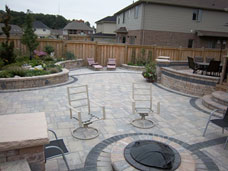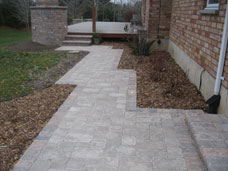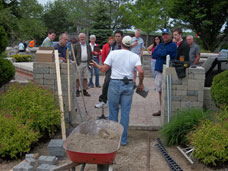Guide to Interlocking Paver Repair and Maintenance

Sealers
Coating the surface of your pavers with a sealer will help to maintain colour while minimizing surface damage and staining that can occur over time. Typically, resealing your pavers every two or three years is enough. Thoroughly sweep and clean the existing surface before applying the sealer. Depending on the size of your patio, either a brush or sprayer can be used. There are many commercial paver sealers on the market. If you are unsure, we can make a recommendation based on our intimate knowledge of the characteristics of your specific purchase.
Polymeric Sand

Hopefully, polymeric sand was used in the initial construction of your patio or walk. If not, once the original sand begins to disappear, you can repair the overall patio by replacing the old sand with polymeric sand. A pressure wash or jet spray from a hose will wash out most of the old sand. After everything is dry, polymeric sand can be swept into the paver joints. You will need to lightly mist the entire surface so the sand settles, and sweep additional sand into any voids. Ask one of our expert staff if you have a special situation and need guidance.
Edge Repair

- Remove the edge pavers.
- Restake the edging to the proper alignment.
- Replace the pavers, adding a little more sand underneath as needed so the surface is even.
- Sweep polymeric sand into the joints.
Resetting Pavers
Sometimes, one or two individual pavers in the middle of a patio or walk settle or rise relative to the other pavers. When a section of the surface is uneven, the repair is not as difficult as you may think. The hardest part is removing the first paver. Though there are special paver extractor tools, a couple of flat head screwdrivers and some elbow grease will usually work just as well.
- Remove all of the pavers that need to be reset, whether it is one or ten.
- Add small amounts of sand to the base course as needed to make the final surface level.
- Be sure to compact the additional sand.
- Replace the pavers and tamp them into place.
- Sweep polymeric sand into the joints.
This covers the basic paver repairs that you are likely to need from time to time. A couple of hours work once or twice a year is usually all that is needed to keep your interlocking concrete pavers in good condition. If you are ever unsure of the best way to proceed with a repair, talk to the experts at Grand River Natural Stone. In Stone Creek and Fergus, our staff are ready to answer your questions and discuss your vision. Call us today.